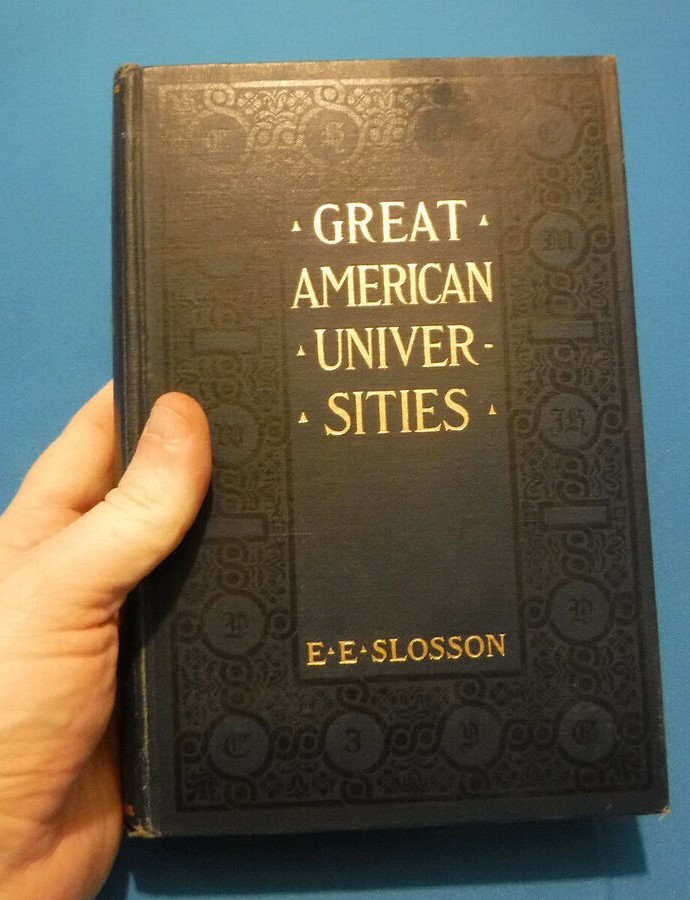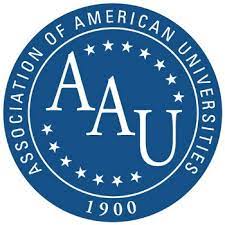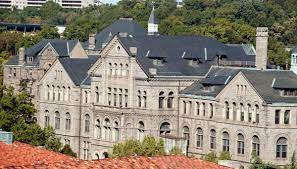
“Between 1880 and 1890 only a handful of institutions in the United States had legitimate claim to being a “real university.” Apart from the 5 below, the list of serious contenders was slim.
- Johns Hopkins
- Cornell
- Harvard
- Clark
- Columbia
Although building the American university attracted a great deal of attention, most articles at the time dealt with the aspirations for what the future American university might be rather than reporting on what it actually was. All this changed dramatically over the next three decades. A landmark event occurred in 1900, when the presidents of fourteen institutions met to form the Association of American Universities. The charter members were:
| 1900 | 1910 |
| Inaugural AAU membership | Slosson’s 1st study & ranking of colleges |
| Columbia | Columbia |
| Cornell | Cornell |
| Harvard | Harvard |
| Penn | Penn |
| Princeton | Princeton |
| Yale | Yale |
| California | California |
| Michigan | Michigan |
| Wisconsin | Wisconsin |
| Chicago | Chicago |
| Johns Hopkins | Johns Hopkins |
| Stanford | Stanford |
| Catholic | Illinois |
| Clark | Minnesota |

This 1900 AAU list of 14 universities consisted of 6 Ivy League colleges, 3 public universities (Cal, Michigan, Wisconsin), and 5 other private universities. Only two overall were on the West Coast (Stanford & Cal). Nine of the colleges were in the Northeast (maybe not Johns Hopkins in Baltimore or Catholic in D.C.) with Michigan, Wisconsin, and Chicago being the only Midwestern representatives.
“In 1910 Edwin Slosson, editor of the magazine The Independent, observed that one now could identifya cluster of ‘”great American universities.” Slosson was an influential journalist who held a Ph.D. in chemistry from the University of Chicago. His focus on the national importance of American universities as a novel entity was no whim. He spent two years visiting institutions and then devoted over five hundred pages to scrutinizing fourteen institutions that he selected for a series of monthly articles. The series was so successful that the collected profiles were then published as a complete book, Great American Universities.

Slosson’s selections overlapped closely with the charter membership of the Association of American Universities, with a few notable changes that illustrated how quickly institutional reputations could rise or fall. Clark University of Worcester, Massachusetts, and the Catholic University in Washington, D.C. – both members of the original AAU-_were absent from Slosson’s elite group. In their place he included two state universities from the Midwest: the University of Illinois and the University of Minnesota. Slosson’s selections also depicted the continuity in campus prestige. Apart from these alterations, twelve of the original AAU members of 1900 retained their high standing, at least according to Slosson’s criteria.
Philosophical arguments and extravagant designs were the order of the day, but it was an open forum that had no expert jury to impose standards. Donors and presidents at one university had little knowledge of or concern about what was going on elsewhere unless, of course, it was seen as a threat to their own work.

Given this environment of ambition and wealth without order or rules, between 1880 and 1910 there was a high shakeout rate among ambitious institutions. Competing for talent, raiding the faculty of rival institutions, and building lavish facilities were common practices. This phenomenon was hinted at by Clark University and the Catholic University dropping out of the top rank between 1900 and 1910. In the case of Clark University, its distinctive plan for emphasis on graduate studies and advanced work in the behavioral sciences fell victim to an inadequate operating budget. Public knowledge of this weakened financial position left Clark vulnerable to rival institutions. A faculty raid led by President Harper of the University of Chicago sealed Clark’s descent from the top rank of universities. The Catholic University in Washington, D.C., failed to fulfill its promise of providing a national locus for advanced scholarship with a distinctive Catholic perspective. Each institution had its own saga of great expectations followed by disappointments and derailments.” From Thelin’s History of American Higher Education

